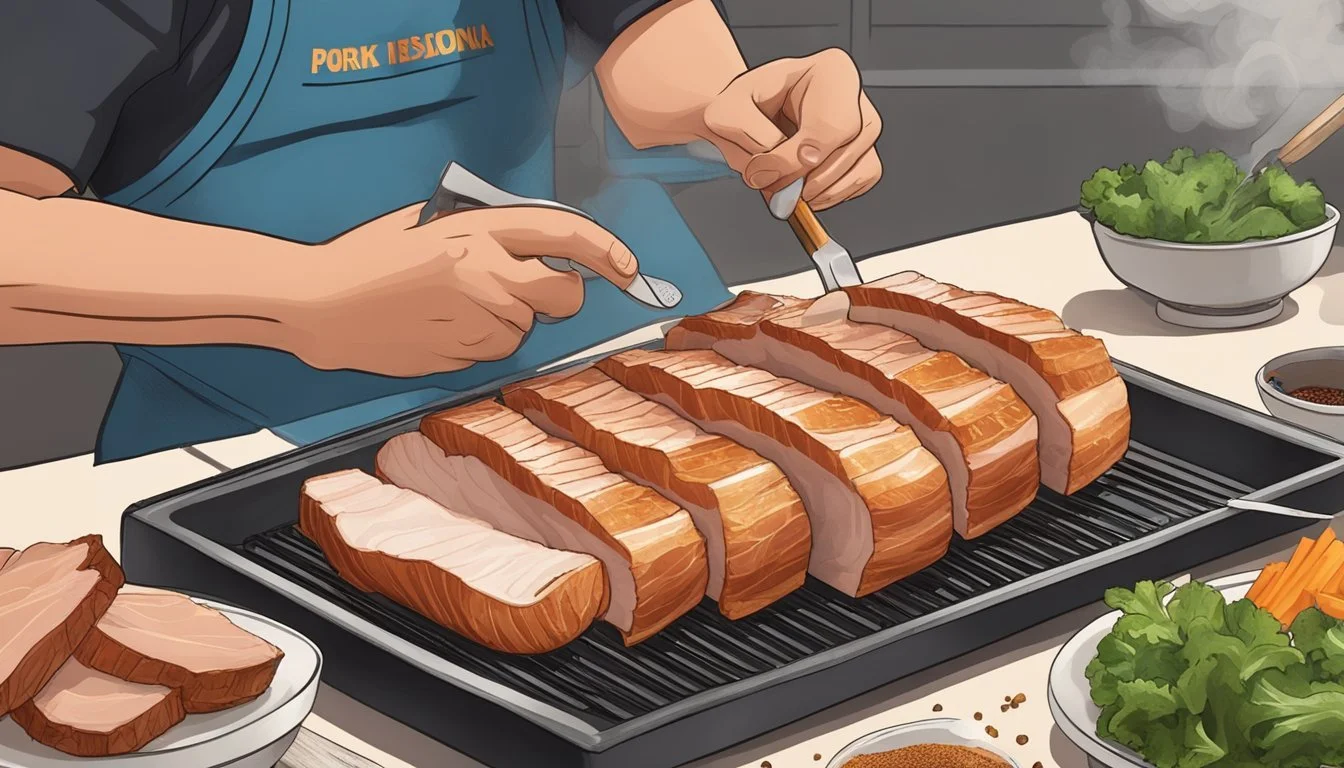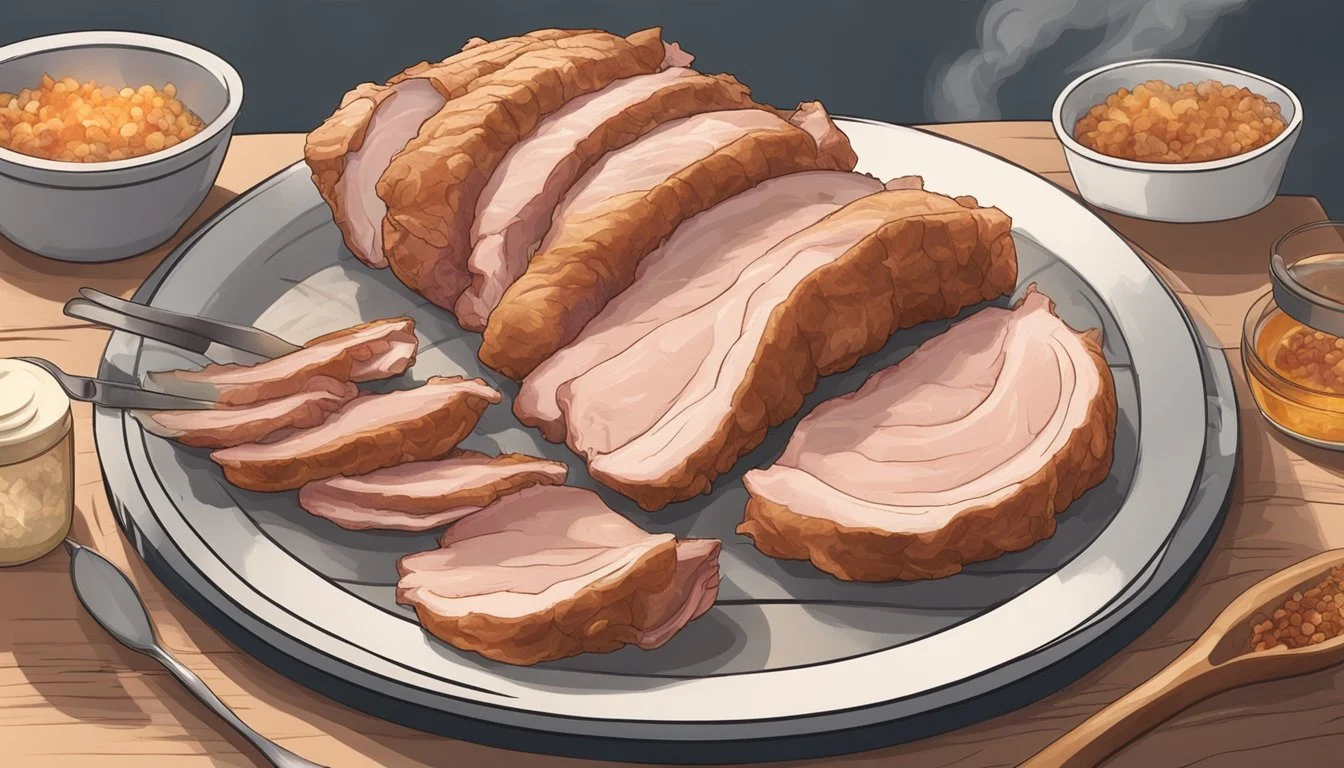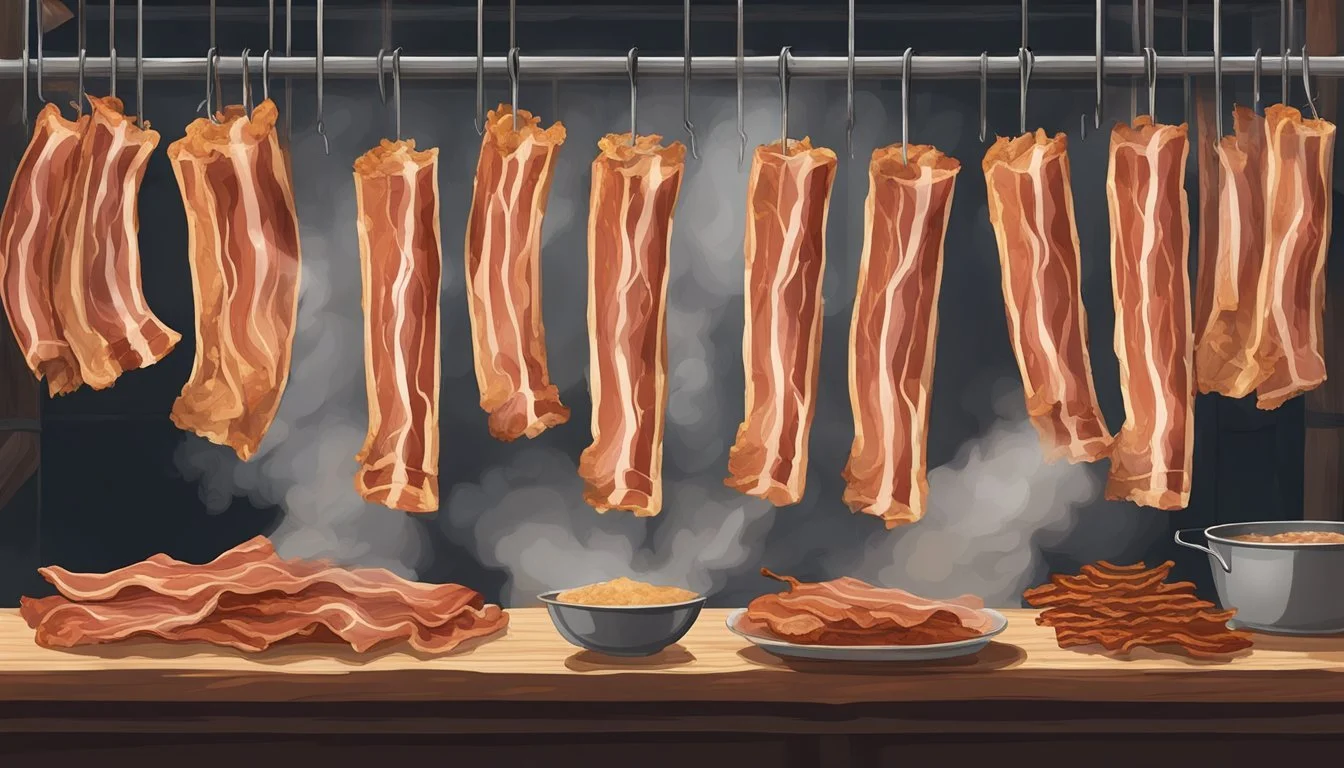Smoked Bacon
The Ultimate Guide to Mastering Preparation, Flavoring, and Cooking Techniques
Smoked bacon (how long does bacon last?) represents a culinary journey that transforms simple pork bellies into a rich, smoky sensation capable of tantalizing taste buds. The process begins with the pivotal curing step, where a mixture of kosher salt, (how long does kosher salt last?) potentially combined with Prague powder for preservation, and a variety of flavor enhancers such as black pepper, garlic powder, (how long does garlic powder last?) and even citrus zest are applied to the meat. This not only infuses the pork with robust flavors but also plays a crucial role in moisture control, ensuring a shelf-stable end product. The art of curing is a careful balance, requiring precision in both the ingredients and time, as the pork must absorb the flavors over several hours or days while wrapped securely, often in plastic wrap, to contain the natural flavors.
Once cured, the bacon is ready for smoking, a complex process that further intensifies its flavor profile. Wood chips, like hickory or apple, are selected for their ability to impart a subtle smoky flavor that complements the meat's richness. In a pellet smoker or a grill set for indirect heat, the pork bellies are transformed as they absorb the delicate, smoky nuances from the burning wood chips. Cold smoking is a popular technique for achieving a deeper depth of flavor without cooking the meat, whereas a higher internal temperature approach results in fully cooked bacon. It is a balance of temperature and time, as bacon must reach a safe internal temperature before it's ready to be enjoyed.
The result of this intricate process is bacon that is free from artificial flavorings, with a rich, natural taste that store-bought varieties often fail to match. Clean meat, fresh herbs (how long do fresh herbs last?), and natural sea salt come together to create not just a piece of bacon, but an experience. Whether it's enjoyed on its own or as part of a greater dish, smoked bacon offers a medley of flavors — from the slightly bitter to the distinctly savory — ensuring every slice is a testament to the care and craft that went into its creation.
Selecting and Preparing the Pork Belly
The first step to making exemplary smoked bacon begins with choosing a premium cut of pork belly (What wine goes well with pork belly?) and preparing it with a cure that enhances its flavor. This preparation sets the stage for the depth of flavor that characterizes good bacon.
Choosing High-Quality Pork
Selecting the right pork belly is crucial. Look for fresh, high-grade pork bellies with a uniform thickness for even cooking. Ideally, the pork should have a good balance of meat to fat and a firm texture. Avoid cuts that appear old or have any gouges. A whole pork belly typically weighs around 10 pounds and should have the skin still on, which can be referred to as the rind.
Trimming and Portioning the Meat
Once the pork belly is chosen, trimming excess fat to ensure an even thickness can be beneficial. It helps to cut the belly into manageable pieces or strips that will fit your smoker or grill. This makes the meat easier to handle and cure. Use a clean, sharp knife and a sturdy cutting surface, maintaining food safety practices to prevent cross-contamination of raw meat.
Applying a Dry Cure
The curing process is critical for flavor development and preservation. A basic dry cure mixture includes kosher salt, black pepper, garlic powder, and often Prague powder (curing salt), which helps prevent spoilage. Some recipes may call for additional flavor enhancers like citrus zest, chili powder, or fresh herbs, which contribute natural flavors without artificial flavorings.
Mix the primary ingredients thoroughly:
1 cup of kosher salt
½ cup of sugar
2 tablespoons of black pepper
2 teaspoons of Prague powder
Rub the cure mixture evenly over the pork, then wrap the pieces in plastic wrap or place in a plastic bag. The pork should be refrigerated during the curing process, which can take up to a week. The pork belly should reach an internal temperature of about 150°F during the smoking process for proper doneness.
Flavoring the Pork with a Cure
Properly flavoring pork with a cure is integral to crafting delicious smoked bacon. The process involves a blend of salts and spices, along with optional sweeteners and additional flavors, to both preserve and enhance the taste of the pork. Determining the right curing time is equally important to ensure flavor penetration and food safety.
Using Salts and Spices
The foundation of any cure is salt. It serves not just to flavor the pork, but also to preserve it and prevent bacterial growth. For the typical bacon cure, non-iodized salt (how long does iodized salt last?) is recommended, sometimes specifically pink curing salt (containing sodium nitrite) which contributes to the characteristic pink color and flavor of cured meats (What wine goes well with cured meats?).
The spices used can vary widely, but common choices include:
Black pepper
Garlic powder
Paprika
Each adds their own unique profile to the meat and should be used sparingly to ensure a balanced end result.
Adding Sweeteners and Flavors
One may add sweeteners to complement the savory and salty notes of the cure. Here are typical sweeteners:
Brown sugar
Maple syrup (how long does maple syrup last?)
Additional flavors can also be infused into the cure mixture. This might include:
Applewood for a subtle smokiness
Cherrywood for a mild, fruity flavor
These sweeteners and flavors are optional, but they play a critical role in creating the complex taste profile that artisan smoked bacon is known for.
Determining Curing Time
Curing time is critical and largely depends on the thickness of the pork and the method used. For a standard pork belly intended for bacon, curing might take between 5 to 10 days. One should ensure the meat is fully submerged or coated in the cure and stored in a refrigerator during this time to maintain an adequate temperature.
Here is a simple guide for curing time:
Thickness of Pork: 1 inch
Recommended Curing Time: 5-7 days
Thickness of Pork: 1.5 inches
Recommended Curing Time: 7-10 days
Thickness of Pork: 2 inches
Recommended Curing Time: 10-14 days
Meat should be turned once a day to promote an even cure throughout the entire cut. After curing, it should be rinsed to remove excess salt from the surface and then dried to form a pellicle before smoking begins.
Cold Smoking Process
Cold smoking bacon involves a delicate balance of maintaining low temperatures to impart flavor without cooking the meat. Mastery of smoker setup, wood chip selection, and temperature control is essential for achieving the perfect smoky taste without compromising safety and quality.
Setting Up the Smoker or Grill
To begin cold smoking, one needs a smoker or grill that can maintain steady low heat. Proper airflow is crucial to prevent the buildup of creosote, which can impart a bitter taste. If using a grill, set it up for indirect heat, positioning the bacon away from the heat source. Using a pellet smoker or a similar device can help maintain consistent temperatures and smoke levels, allowing for greater control over the cold smoking process.
Choosing the Right Wood Chips
Selecting the right wood chips is essential to develop a desired flavor profile. Fruit woods such as apple or cherry can add a sweet note, while hickory or oak will contribute a stronger, more robust smoky flavor. One should avoid woods that can impart harsh or bitter flavors. Wood chips should be soaked in water for at least 30 minutes to ensure they smolder and produce smoke rather than burning up quickly.
Monitoring Temperature
Cold smoking is typically conducted at temperatures less than 85°F (30°C). It is important to use a reliable thermometer to monitor the internal temperature closely, ensuring that it remains within this range throughout the process, which can last from hours to days. The product's internal temperature should also be monitored to ensure it does not enter the temperature danger zone (40°F - 140°F or 4°C - 60°C), to minimize the risk of bacterial growth on the raw meat.
Slicing and Cooking the Bacon
Preparing and cooking bacon is a fulfilling process that transforms pork bellies into a savory delight. Proper slicing and cooking techniques are paramount for achieving bacon with a depth of flavor and the desired crispness.
Slicing into Manageable Pieces
To slice bacon into manageable pieces, make sure the meat is cold as this will ease the cutting process. A sharp knife is essential to cut through the raw meat cleanly. Depending on personal preference, slices can range from thin to thick, with thicker slices requiring a longer cooking time to achieve the perfect crispness. It is important to slice the bacon consistently to ensure even cooking.
Thickness: 1/8 inch (thin) to 1/4 inch (thick)
Temperature: Chill pork bellies in a refrigerator before slicing
Tools: Use a sharp knife or a meat slicer
Safety Tip: Keep fingers away from the blade as you slice
Getting the Perfect Crispness
Achieving the perfect crispness begins with the curing process. Adding a mixture of kosher salt, black pepper, garlic powder, Prague powder, and optional flavor enhancers like citrus zest can enhance the natural flavors. For flavor depth, consider using fresh herbs and dry spices such as chili powder. Cure the pork bellies in a mixture of these ingredients and wrap in plastic wrap, allowing them to rest for hours, infusing the flavors.
Curing Ingredients: Kosher salt, black pepper, garlic powder, Prague powder
Flavor Enhancers: Citrus zest, chili powder, fresh herbs
Curing Time: Typically several hours to overnight
After Curing: Rinse the meat with fresh water to remove excess salt
Cooking on Grill or in Oven
For grilling, cook bacon over indirect heat on a preheated grill, using a baking sheet or foil to catch drips and prevent flare-ups. The internal temperature should reach 150 degrees Fahrenheit to ensure doneness. In the oven, lay the bacon on a wire rack over a baking sheet and cook at 375 degrees Fahrenheit until it reaches desired crispness. Both methods impart a smoky flavor, with a pellet smoker or wood chips adding extra smoky notes.
Grill Method: Use indirect heat, preheat to medium, check at 15 minutes
Oven Method: 375 degrees Fahrenheit, place on wire rack over baking sheet
Internal Temperature: 150 degrees Fahrenheit for doneness
Extra Smoky Flavor: Use a pellet smoker or add wood chips to the grill
Recipes and Serving Ideas
Smoked bacon enhances a variety of dishes with its rich, smoky flavor. From salads to soups and even appetizers (What wine goes well with appetizers?), the versatility of smoked bacon allows it to be a standout ingredient that adds both taste and texture to any recipe.
Salad Toppings and Dressings
The crispiness of smoked bacon adds a delightful crunch and depth of flavor to salads. For a simple yet flavorful enhancement, one can crumble smoked bacon into a salad or whip up a dressing using bacon grease as a base, mixing in balsamic vinegar, fresh herbs, and a touch of honey. The saltiness of the bacon balances well with the natural sweetness of the dressing, creating a perfect union of flavors.
In Soups and Beans
Adding smoked bacon to soups or a pot of beans is a traditional way to infuse a smoky depth into every bowl. The bacon should be cooked until crisped, then incorporated into the soup where it will impart its flavors during simmering. Black pepper and garlic powder can be sprinkled over the bacon beforehand to enhance its taste profile. Whether it's a white bean soup garnished with bacon and rosemary or a hearty chili enriched with bacon, the added layer of flavor will satisfy the taste buds.
Appetizers and Snacks
For appetizers, smoked bacon can be used as a central feature or a complementary flavor enhancer. Wrapping pieces of shrimp or scallops in bacon and cooking them until the bacon is crispy creates a popular appetizer, with the seafood providing a delicate sweetness and the bacon adding a savory bite. One could also cut smoked bacon into manageable pieces and serve alongside a range of dips, such as ones flavored with citrus zest and lime juice to balance the savory, smoky taste of the bacon.






